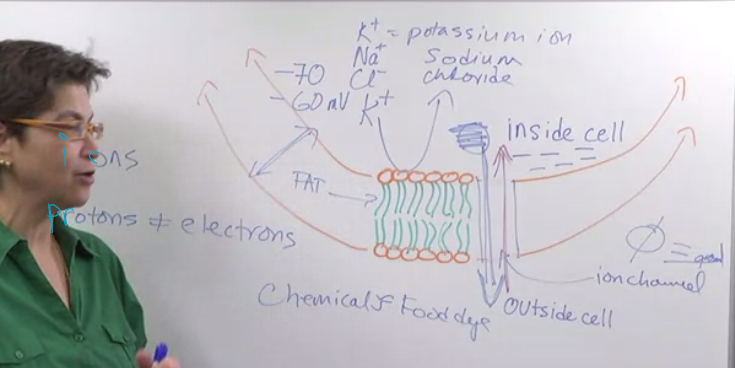Neurons and Electrical Signals
Ions and Membranes:
- Neurons use ions (charged molecules) instead of electrons for electrical signals.
- Ions can be positively charged (e.g., potassium K+) or negatively charged (e.g., chloride Cl-).
- The cell membrane is a fatty layer that acts as a barrier for ions.
- Ion channels are special openings in the membrane that allow specific ions to pass through.
Ion Distribution and Resting Potential:
- Ions have a chemical force (like a dye) that pushes them to distribute evenly across the membrane.
- The cell interior is negatively charged, while the exterior is close to neutral (grounded).
- This creates an electrical force attracting positively charged ions inside the cell.
- A balance between chemical and electrical forces determines the resting membrane potential (around -70 to -60 millivolts).
Key Points:
- Neurons use a special system with ions and channels for electrical signaling.
- The cell membrane plays a crucial role in controlling ion flow.
- Resting potential is a delicate balance between opposing forces.

Electrical Terms Analogy: Water and Neurons
This lecture uses a water analogy to explain electrical terms in the context of neurons:
- Potential: Similar to water level, it represents the “voltage” difference between two points. No difference, no flow (current).
- Current: The flow of water (charged ions in neurons) driven by the potential difference. Higher potential difference (waterfall) creates a stronger current.
- Resistance:
Key Points in Neurons:
- Potential difference: Measured in millivolts (mV), it exists between the inside and outside of the cell (around -65 mV).
- Ion channels: These are openings in the membrane that allow charged ions (current carriers) to move in and out of the cell.
- Resistance: The cell membrane itself has resistance to the flow of ions, which can be influenced by the number of open ion channels.
- Action Potential
- Neurotransmitter Synthesis
- Signal Termination